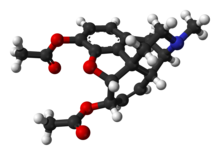Diacetylmorphine
 |
|
 |
|
| Clinical data | |
|---|---|
| Pronunciation | Heroin: /ˈhɛroʊɪn/ |
| AHFS/Drugs.com | heroin |
| Dependence liability |
Physical: Very high Psychological: Very high |
| Addiction liability |
Highly |
| Routes of administration |
Intravenous, inhalation, transmucosal, by mouth, intranasal, rectal, intramuscular, subcutaneous, intrathecal |
| Drug class | opiate |
| ATC code | N07BC06 (WHO) |
| Legal status | |
| Legal status |
|
| Pharmacokinetic data | |
| Bioavailability | <35% (by mouth), 44–61% (inhaled) |
| Protein binding | 0% (morphine metabolite 35%) |
| Metabolism | liver |
| Onset of action | Within minutes |
| Biological half-life | 2–3 minutes |
| Duration of action | 4 to 5 hours |
| Excretion | 90% kidney as glucuronides, rest biliary |
| Identifiers | |
|
|
| Synonyms | Diamorphine, Diacetylmorphine, Acetomorphine, (Dual) Acetylated morphine, Morphine diacetate |
| CAS Number |
561-27-3 |
| PubChem (CID) | 5462328 |
| DrugBank |
DB01452 |
| ChemSpider |
4575379 |
| UNII |
8H672SHT8E |
| ChEBI |
CHEBI:27808 |
| ChEMBL |
CHEMBL459324 |
| ECHA InfoCard | 100.008.380 |
| Chemical and physical data | |
| Formula | C21H23NO5 |
| Molar mass | 369.41 g/mol |
| 3D model (Jmol) | Interactive image |
|
|
|
|
Heroin, also known as diamorphine among other names, is an opiate typically used as a recreational drug for its euphoric effects. Medically it is occasionally used to relieve pain and as a form of opioid replacement therapy alongside counseling. Heroin is typically injected, usually into a vein; however, it can also be smoked, snorted or inhaled. Onset of effects is usually rapid and lasts for a few hours.
Common side effects include respiratory depression (decreased breathing) and about a quarter of those who use heroin become physically dependent. Other side effects can include abscesses, infected heart valves, blood borne infections, constipation, and pneumonia. After a history of long-term use, withdrawal symptoms can begin within hours of last use. When given by injection into a vein, heroin has two to three times the effect as a similar dose of morphine. It typically comes as a white or brown powder.
Treatment of heroin addiction often includes behavioral therapy and medications. Medications used may include methadone or naltrexone. A heroin overdose may be treated with naloxone. An estimated 17 million people as of 2015 use opiates such as heroin, which together with opioids resulted in 122,000 deaths. The total number of opiate users has increased from 1998 to 2007 after which it has remained more or less stable. In the United States about 1.6 percent of people have used heroin at some point in time. When people die from overdosing on a drug, the drug is usually an opioid.
...
Wikipedia
